Abstract
The global changes in area of information innovations and technologies which happened in the world brought modern economy into the status digital. The new economy is already characterized by digital inequality which will increase more and more. Questions of a trajectory of innovative development during an era of economy of knowledge and digitalization become relevant and their value increases. In this article authors tried to answer a question what drivers of growth are necessary for regions for their inclusion in the growing innovative trend of job specialization and whether cluster approach is capable to solve the designated problems. Authors tried to find the response to the revealed restrictions connected with network infrastructure of clusters. On the example of the Kaliningrad region the directions of the solution of the designated problems are shown. For more complete analysis features of pilot innovative clusters, leading clusters and industrial clusters were studied. The industry structure of gross value added of the Kaliningrad region is analyzed and the most reasonable direction connected with the organization of scientific and innovative activities in the Kaliningrad region is shown. In Russia the main forces of workers in an industry of science and education generally rely on personal, pointed interactions that limits a circle of scientific knowledge. Personal interactions are the narrowest link which limits innovative nature of development and leads to restriction of network infrastructure (further in the text "ecosystem").
Keywords: Economyregionscience and innovation clustersustainability
Introduction
For the last decade in the world there were global changes in area of information innovations and technologies that brought modern global economy into the status digital. The new economy is already characterized by digital inequality which will increase more and more. However, in it there are also benefits to those countries which will be able accurately to formulate a vector of the development and to apply all potential of knowledge and creativity, for the benefit of the country, having made it the central link of economic growth. The economy of the future will be connected not only with production processes of highly innovative products and increase in profit, but also with creation in a large number of non-material values. The vector of digital development will be based on the knowledge economy and first of all on the new principles of education, acquisition of new skills (competences) and the increase in life expectancy. Already today in the increasingly open information space, information systems and network infrastructures are faced by a nimber of questions: "How to achieve easier generation of the innovative ideas and dissemination of knowledge on all range of questions?" and "How to realize (to implement) these ideas into practice?".
In Russia the main forces of workers in an industry of science and education generally rely on personal, pointed interactions that limits a circle of scientific knowledge. Personal interactions are the narrowest link which limits innovative nature of development and leads to restriction of network infrastructure (further in the text "ecosystem").
The ecosystem, certainly, influences an innovative way of development of the countries, integrity of the creative atmosphere as well as the experience generated and the unique settings in separate clusters.
In this regard planning of innovative activities in the Kaliningrad region during an era of global economy demands from all participants of the approach based on knowledge. The new paradigm of a social-economic and spatial-strategic development was for the first time approved in Silicon Valley, Cambridge Science Park and Sophia Antipolis, and then accepted by the leading cities of Europe, North America, Australia and Asia, such as, for example Austin, Barcelona, Boston, Delft, Manchester, Melbourne, Singapore, Toronto (Yigitcanlar, 2010; Yigitcanlar, Velibeyoglu, & Baum, 2008).
Modern cluster planning requires from their initiators more innovative approaches and solutions based on digital infrastructure, green technologies and other infrastructure solutions that can quickly revitalize the environment, while providing economic opportunities to strengthen the cluster's global competitiveness (Bitokova, 2010).
Problem Statement
In Russia, there are number of territories having special geographical conditions for development, for example, the Kaliningrad region is remote from the main part of Russia by the borders of foreign countries that creates problems for it which have a negative development on its competitiveness, compared to European countries and the Russian Federation.
The exclusive character of the Kaliningrad region generates a number of major problems that affect its innovative development path:
low level of industrial production;
obsolete equipment: physically and morally;
the products are oriented to the market of Russia and the CIS;
infrastructure of the region has the high level of wear;
there are restrictions in the field of an energy complex;
environmental problems aren't solved;
the presence of polder lands and territories with flooding;
low attractiveness of the agricultural industry.
Today key industries of the Kaliningrad region are the transport and logistic complex, agro-industrial complex, an energy complex, the food industry, including fish processing, mechanical engineering and metal working, a tourist and recreational complex. It is possible to allocate with a separate element of industry structure of gross value added of the Kaliningrad region education which is a strong link in an institutional basis of the region.
Next in Figure
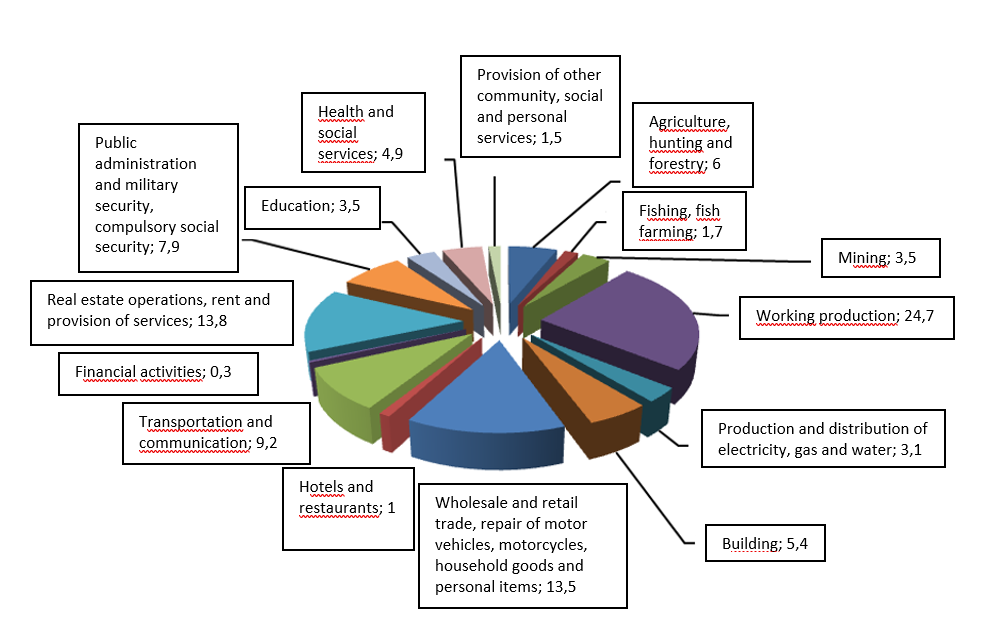
The analysis of dynamics of development of economy of the Kaliningrad region shows that in the region only two clusters amber and automobile are created for today. The process of forming clusters is difficult, but if they can occupy competitive niches, they will be of interest not only for enterprises of the Russian Federation but also for the countries of the European Union.
The industry structure of gross value added of the Kaliningrad region showed that in the market of the region producers of the fish and food industry, furniture production, assembly of cars and household appliances dominate. At the same time a considerable part of the made products of area is traded in the market of Russia and the overall performance of the entities depends on support of the federal authorities today (Resolution of the Government of the Russian Federation No. 866 of 07 December 2001).
In order to develop clusters in the Kaliningrad region, the regional government is creating an integrated support infrastructure designed to intensify the chosen course and fully load the scientific potential of the region.
To optimize management, a single structure was created under the name “Center for the Development of Entrepreneurship of the Kaliningrad Region” including: “Entrepreneurship Support Fund”, “Microfinance Fund”, “Guarantee Fund” and “Industry Development Fund”, and medium business ".
In order to coordinate the clustering process, in 2018 a cluster development center was created in the Kaliningrad region, and today it is used as a link between business and government.
Despite the existing problems, the region has all the resources to create innovative clusters, the basis of which should be the entire available potential of research and innovation activities in the Kaliningrad region.
Research Questions
Given the gap in building science and innovation clusters in the existing literature, the questions for this study will be the following:
What are the drivers of growth in science and innovation in the Kaliningrad region?
Whether cluster approach, namely scientific and innovative to solve this problem is capable?
Purpose of the Study
Objectives of this research are:
to study factors and drivers of growth of scientific and innovative activities in the Kaliningrad region;
to develop approach to creation of a scientific and innovative cluster in the Kaliningrad region.
Research Methods
Today, science and innovation clusters are developing in “new sectors” of the economy, such as information, bio- and nano-technologies, in areas where new materials are being designed, as well as in services related to creative activities. More details are available (World Economic Forum, 2018). Scientific and innovative clusters integrate into themselves a significant amount of the new young companies arising in the course of implementation of commercialization own technologies and as a result of scientific activities which are conducted by specialists in higher educational institutions and the research organizations.
It is necessary to understand that all types of cluster groups in "new sectors" which represent statistical groups in new regional economy can be scientific and innovative. The researches European Cluster Observatory show that low employment numbers indicate the absence of cluster groups in the studied agglomeration.
In this regard, M. Porter proposes to use the "Coefficient of localization" (Porter, 2012), which is calculated using the following formula:

Moreover, if the obtained value of LQ> 1, then this industry prevails in the regional economy, the threshold value, according to M. Porter, is 0.8.
The European Cluster Observatory used the methodology (Porter, 2012) to refine it and suggested additionally using the “Size” and “Focus” criteria to determine meaningful cluster groups. The “size” of a cluster group is calculated using the following formula:
(2)
where Size – "Size" of cluster group i;
Empig – quantity of occupied in cluster group i in the region g;
Empi – quantity occupied in cluster group i.
"Focus" of cluster group is calculated by the following formula:
(3)
where Focus – "Focus" of cluster group i;
Empig – the number of employees in cluster group i in the region g;
Empg – number of employees in the region g.
As threshold European Cluster Observatory values, the following criteria are established:
"Localization coefficient" ≥ 2;
The region should be among 10% of the regions leading by "Size" of the considered cluster group;
The region should be among 10% of the regions leading on "Focus" of the considered cluster group.
Project implementation on creation and development of a scientific and innovative cluster will allow to overcome effectively the "bottlenecks" interfering development of the modern highly intellectual companies and organizations in the Kaliningrad region. Among the most striking problems that can be overcome in the framework of the development of the science and innovation cluster of the Kaliningrad region are the following:
research backwardness on key activities of a cluster, including scientific and educational to a component;
low technology commercialization;
difficulties with access to financial resources of the new technological companies;
low level of specialized services for start-up technology companies;
inefficient industry regulation.
Using the experience of the European Cluster Observatory of the leading institutions of cluster policy, we will try to identify the sectoral digital needs of the Kaliningrad region through common activities.
Findings
Researches show that development of territorial clusters, certainly, is are perspective the direction for regions as they result in efficiency of regional economy and raise competitiveness of the companies (Shamardin, 2013).
According to the portal “Map of Clusters of Russia”, in 2016, there were 39 regional clusters in Russia, which included more than 2.8 thousand companies, as well as infrastructure facilities that involved more than 1.2 million people (Territorial clusters, 2016).
It is known that the level of development of the countries depends not only on implementation and use of advanced technologies today, but also and on the number of the taken-out patents and means spent for research and development works and also on the level of all education system and science in general.
Today, Western countries spend more significant sums on research and development than in Russia, so the European Union spends on average $ 344.9 billion on research and development in 2016 spent over $ 464.3 billion on research and development. In turn, China over 410.1 billion dollars and Japan of 149.4 billion dollars. The Russian Federation (37.2 billion dollars) is significantly behind the previously listed countries by more than 8 times in the indicator under study (OECD, 2017).
In Figure
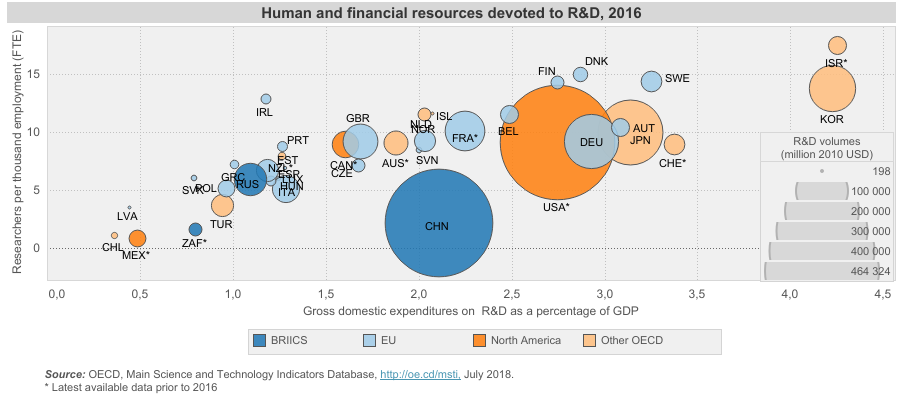
From Figure
The effectiveness of R & D development often also depends on a number of reasons, which are based on entrepreneurial business confidence; in this regard, the authors analyzed the dynamics of this indicator and built the following diagram (Figure
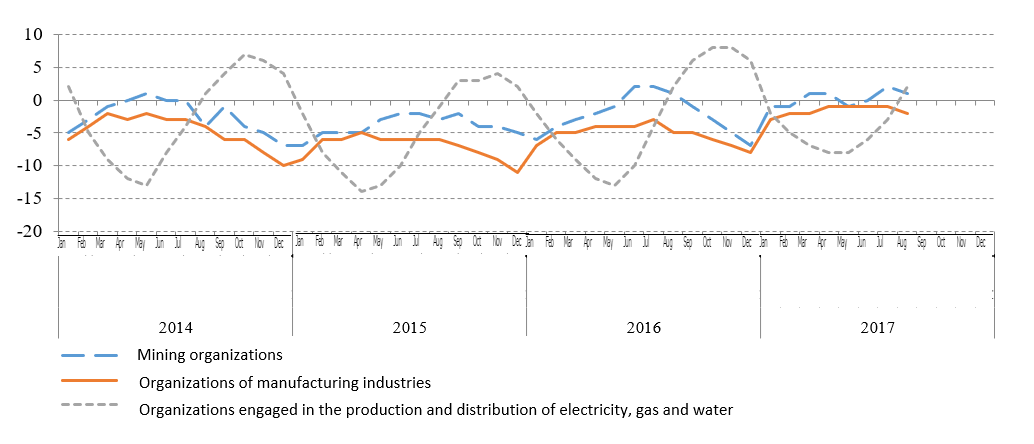
The index of entrepreneurial confidence characterizes the generalized state of entrepreneurial behavior, in August 2017 compared to August 2016 remained unchanged in the extractive industries at the level (1%), in the manufacturing industries has a positive trend from (-5%) to (-2 %) and did not change in terms of production and distribution of electricity, gas and water (2%).
Below in Figure
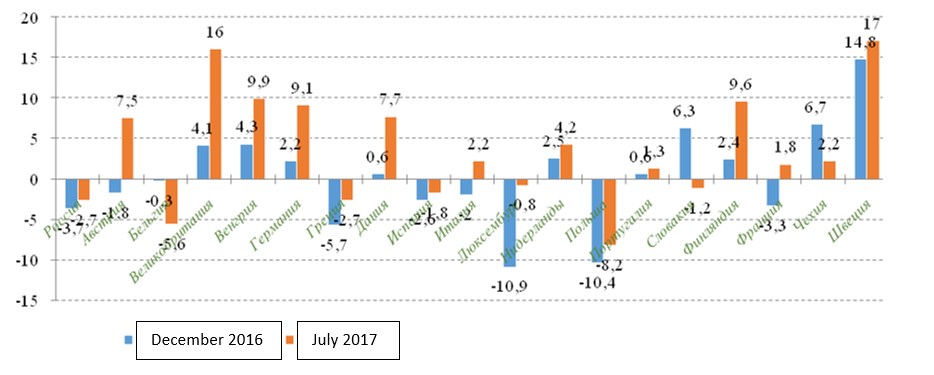
Analysis Figure
Next in Figure

According to Eurostat the total specific weight of the companies performing technological innovations doesn't exceed 10% today, however leaders of the European states have this indicator over 30%. Apparently for Russia development potential in this direction isn't exhausted.
Using the mechanism of quantitative and high-quality control of growth of key indicators of social and economic development of regions of Russia in interrelation with the major target indicators which are provided in this article and indicators of various regional programs, strategy and forecasts of regional development it is possible to create effective model of clusterization of regional economy and to provide a strong growth of development of the region on the basis of synergy effect in all industries.
The number of constraints in the development of clusters in Russia and regions include:
depreciation of fixed assets;
loss of positions in the near and far abroad;
degradation of science and innovation;
increased competition in the Russian market.
Summing up the results, it is possible to determine a fundamental problem of development of scientific and innovative clusters, which is that most companies have significant difficulties in “cheap” money to implement their development and innovation, as well as due to the lack of government support system and implementation developments for young companies and startups (Polyakov, Balyasnikova, & Chumakov, 2016). The further way lies in the plane of development of research and innovation clusters.
Today in Russia the vector of cluster development is one of the priorities of state policy (Order of the Government of the Russian Federation No. 1662-r of 17 November 2008) and (Order of the Government of the Russian Federation No. 2227-r of 8 December 2011). In order to further develop and activate the clusters, a number of regulatory and legislative acts have been adopted that regulate the activities of the network of innovative regional clusters.
The cluster policy in Russia is implemented by efforts of two national departments: Ministry of Economic Development and Minpromtorg provide support in the form of a subsidy; the Ministry of Economic Development is encouraging the regions to actively create cluster development centers (hereinafter the CDC). As a result of such an active state policy, at present, Russia has established 34 CDCs in 33 regions.
At present, the program of support for pilot innovation clusters is designed to strengthen the cooperation of science and business in clusters, as well as to intensify the development of territories with the highest scientific, technical and production potential.
Using the mechanism of cluster development, the initiators from among the regions developed their own mechanism for achieving the goals in the field of cluster development of the regions, with individual sets of solutions. The initiators and inspirers of the “cluster initiative” in the regions may include executive and legislative authorities, professional development institutions of the country (such as ASI, NTI or the Association of Clusters and Technoparks), as well as professional associations of entrepreneurs who, according to the triple helix principle, effectively interact build cluster
The initiators of cluster development should clearly understand that clusters are part of the microeconomic business environment of a region and can be formed around a certain force (blue arrow in the figure below) associated with the region’s general history and culture, geographical features, common institutions and rules, and also with a common macroeconomic environment. All clusters are influenced within the country by such factors as exchange speed (information, finances, means of labor, personnel, etc.), government responsiveness, historical and geographical conditions of a country or region (Figure
In 2016 the Ministry of Economic Development started the priority project "Development of Innovative Clusters — Leaders of World-class Investment Attractiveness". The project is directed to creation of points of the advancing growth of economy, innovative development, export of high-tech products and commercialization of technologies. Since the end of 2015 Minpromtorg realizes the program of support of industrial clusters. Their participants, who have confirmed their compliance with the requirements of the ministry, can subsidize part of the costs in the framework of projects for the production of import-substituting products (Abashkin et al., 2018).
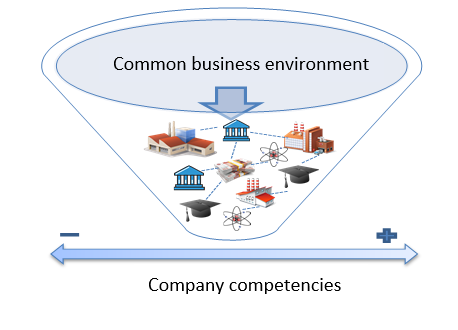
Intercluster projects aimed at mutual use of equipment and infrastructure, joint procurement and product promotion abroad, and the development of competencies of the leading teams of cluster leaders should ensure the maximum effectiveness of cluster support. An important factor in the accelerated development of clusters is the constant exchange of best practices for effective interaction, including in the areas of attracting investment, developing innovation infrastructure and commercialization mechanisms, promoting export products, and organizing advanced research and development.
The authors of the article are of the opinion that to achieve a result in the field of cluster development, first of all, a basic foundation is required, namely its basic ecosystem, which contributes to the prosperity and efficient development of the entire cluster, drawing its effectiveness from the development of layers (Yigitcanlar, O'Connor, & Westerman, 2008), which form the scientific and innovative basis of the “knowledge city” (KC):
knowledge base: including educational institutions and R & D;
industrial structure: influences the progress and initial development of the KC;
quality of life and city amenities: it provides the necessary KC; elements of knowledge workers are attracted to create a solid knowledge base;
urban diversity and cultural mix: as a tool to encourage creativity;
accessibility: encourages and facilitates the transfer of knowledge;
social equity and inclusion: minimizes social inequality and negative tensions;
city scale: large KCs may tend to offer a larger set of knowledge, greater diversity and choice for knowledge workers and businesses.
Taking into account the peculiarities of the studied region, experience and practice of implementing the cluster policy of leading countries, as well as recommendations of leading experts, the authors of the article propose to create a research and innovation cluster in the Kaliningrad region, the organizational model of which is presented in the next Figure
The core of the research and innovation cluster of the Kaliningrad region will consist of:
The leading scientific centers of the region are scientific resources concentrated on the territory of the region that generate the knowledge economy (BFU, KGTU, AtlantNIRO, IZMIRAN, etc.).
Scientific partners - the world's leading scientific and technical centers.
Industrial partners - leading global and regional companies.
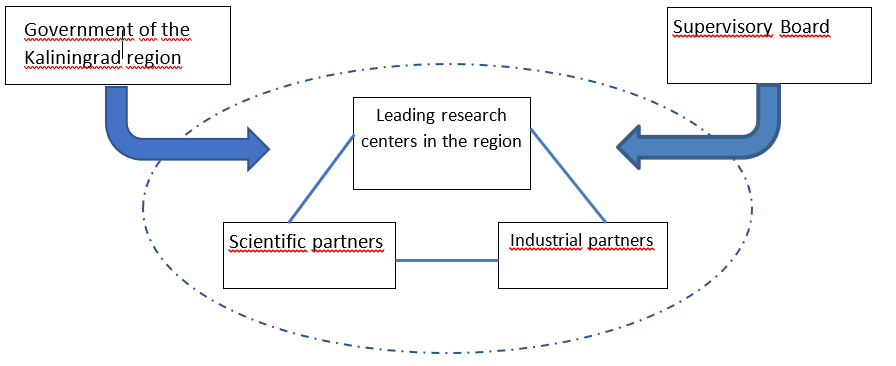
The management of a cluster needs to be transferred to association of cluster development of "A scientific and innovative cluster of the Kaliningrad region" where general coordination will be performed by the Supervisory board consisting of Scientific and Strategic council:
A. Scientific council
Structure:
Leading Russian and foreign scientists.
Functions:
Evaluation and consulting support of projects taking into account trends in world science;
Expansion of cooperative ties of the cluster in scientific circles;
Assistance in attracting leading scientists and specialists to the cluster.
B. Strategic recommendation
Structure:
Representatives of the Government of the Kaliningrad Region and key industrial partners.
Functions:
Evaluation of projects taking into account the development priorities of the region and key partners;
Promoting the interests of the cluster in business circles;
Approval of strategic decisions on the functioning and development of the cluster.
The implementation of the research and innovation cluster of the Kaliningrad region will allow:
to ensure the growth of non-price competitiveness of domestic enterprises;
to ensure the growth of non-primary and high-tech exports of goods and services;
stimulate an increase in the number of small and medium enterprises;
ensure accelerated development of the innovation sector of the economy;
improve the efficiency of the training system for the needs of the economy;
to ensure the growth of direct domestic and foreign investment;
stimulate the socio-economic development of the cluster-based regions.
The research and innovation cluster will become the most important indicator of the innovative development of the Kaliningrad region, it will provide an inflow of intellectual resources, will give impetus to the development of the exclave territory and improve the quality of life due to the concentration of innovative companies in the region. Its development will also create favorable conditions for accelerated approbation of advanced technologies and solutions in the region, and the special location of the region’s territory can serve as an impetus for cooperation with European scientific organizations and institutions.
Conclusion
Under current conditions, according to the authors of the article, the most rational is the development of a science and innovation cluster, since it will facilitate the exchange between scientists working in the Kaliningrad region, as well as being synergistic and glue works between projects. Clustering and discussions in “new industries” play a key role in increasing coherence and promote the mutual enrichment of all cluster members.
The development of innovation and information technology in the Kaliningrad region can only be effective on the basis of a research and innovation cluster, combining: business incubators, innovation creativity centers, research and education centers, data processing centers, coworking, and IT infrastructure facilities, etc.
The disadvantages and limitations arising from its formation can be eliminated by minimizing the identified constraints in the development of the region and more effective implementation of the public-private partnership mechanism.
Such a path can give impetus to the Kaliningrad region and translate the region to an innovative development path in the era of the digital economy.
Acknowledgments
The authors express their sincere thanks to Dr. R.Sh. Hadzhaev for viewing the manuscript and numerous useful tips, positive criticism and valuable comments that were taken into account when finalizing it.
References
- Abashkin, V., Artemov, S., Islankina, E., Kutsenko, E., Rudnik, P., Strakhova, A., & Khafizov, R. (2018). Cluster Policy in Russia: Reaching Global Competitiveness. Moscow: HSE.
- Bitokova, Z. H. (2010). Cluster education as an aspect of sustainable development of the region. Terra economicus, 2-3 (8), 162-167.
- OECD. (2017). OECD Factbook 2017: Economic, Environmental and Social Statistics. Paris: OECD Publishing,
- Order of the Government of the Russian Federation No. 1662-r of 17 November 2008 (as amended on 08.08.2009) "On the Concept of Long-Term Socio-Economic Development of the Russian Federation for the Period up to 2020". Collection of Legislation of the Russian Federation, 47, 5489.
- Order of the Government of the Russian Federation No. 2227-r of 8 December 2011 "On Approval of the Strategy of Innovative Development of the Russian Federation for the Period up to 2020". (2012). Retrieved from URL: http://www.garant.ru/products/ipo/prime/doc/70006124/. Accessed:01.08.18
- Polyakov, R. K., Balyasnikova, E. V., & Chumakov, A. S. (2016). Sectoral sanctions: a policy of import substitution and the development of innovations in the Russian Federation. Vestnik MGTU, 2(19), 502-511.
- Porter, M. E. (2012). Regional competitiveness. London, UK: Routledge.
- Regions of Russia. Socio-economic indicators. (2017). Moscow: Stat. Sat Ros-stat.
- Resolution of the Government of the Russian Federation No. 866 of 07 December 2001 (as amended on 05.05.2016) "On the Federal Target Program for the Development of the Kaliningrad Region for the Period until 2020". Collection of Legislation of the Russian Federation, 52(2), 4974.
- Shamardin, D.N. (2013). Socio-economic development of the region through clusters. Russian Entrepreneurship, 13 (235), 30-37.
- Territorial clusters. (2016). 100 clusters on one map. News digest. National Research University Higher School of Economics, 13(1 - Sept 15). Access mode: https://cluster.hse.ru/mirror/pubs/share/212217484
- World Economic Forum. (2018). Future of Jobs Survey 2018. Access mode: http://www3.weforum.org/docs/WEF_Future_of_Jobs_2018.pdf
- Yigitcanlar, T. (2010). Making space and place for the knowledge economy: Knowledge-based development of australian cities. European Planning Studies, 18(11), 1769-1786. DOI:
- Yigitcanlar, T., O'Connor, K., & Westerman, C. (2008). The making of knowledge cities: Melbourne's knowledge-based urban development experience. Cities, 25(2), 63-72. DOI:
- Yigitcanlar, T., Velibeyoglu, K., & Baum, S. (2008). Knowledge-based urban development: Planning and applications in the information era. PA: IGI Global. DOI: 10.4018/978-1-59904-720-1
Copyright information

This work is licensed under a Creative Commons Attribution-NonCommercial-NoDerivatives 4.0 International License.
About this article
Publication Date
20 March 2019
Article Doi
eBook ISBN
978-1-80296-056-3
Publisher
Future Academy
Volume
57
Print ISBN (optional)
-
Edition Number
1st Edition
Pages
1-1887
Subjects
Business, business ethics, social responsibility, innovation, ethical issues, scientific developments, technological developments
Cite this article as:
Gegechkori, O., Polyakov, R., Nikitina, N., & Chudaeva, A. (2019). Drivers Of Innovative Development Of Regions: The Cluster Approach. In V. Mantulenko (Ed.), Global Challenges and Prospects of the Modern Economic Development, vol 57. European Proceedings of Social and Behavioural Sciences (pp. 1808-1820). Future Academy. https://doi.org/10.15405/epsbs.2019.03.184

